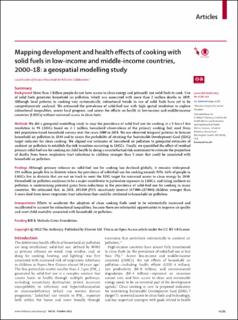| dc.contributor.author | Frostad, Joseph Jon | |
| dc.contributor.author | Nguyen, QuynhAnh P. | |
| dc.contributor.author | Baumann, Mathew M. | |
| dc.contributor.author | Blacker, Brigette F. | |
| dc.contributor.author | Kisa, Adnan | |
| dc.contributor.author | Marczak, Laurie B. | |
| dc.contributor.author | Deshpande, Aniruddha | |
| dc.contributor.author | Wiens, Kirsten E. | |
| dc.contributor.author | LeGrand, Kate E. | |
| dc.contributor.author | Kisa, Sezer | |
| dc.contributor.author | Johnson, Kimberly B. | |
| dc.contributor.author | Hay, Simon I. | |
| dc.contributor.author | Household Air Pol. Collab, Local Burden of Disease | |
| dc.date.accessioned | 2022-12-21T14:26:44Z | |
| dc.date.available | 2022-12-21T14:26:44Z | |
| dc.date.created | 2022-09-14T11:05:40Z | |
| dc.date.issued | 2022-09-13 | |
| dc.identifier.citation | The Lancet Global Health. 2022, 10 e1395-e1411. | en_US |
| dc.identifier.issn | 2572-116X | |
| dc.identifier.issn | 2214-109X | |
| dc.identifier.uri | https://hdl.handle.net/11250/3039105 | |
| dc.description.abstract | Background: More than 3 billion people do not have access to clean energy and primarily use solid fuels to cook. Use of solid fuels generates household air pollution, which was associated with more than 2 million deaths in 2019. Although local patterns in cooking vary systematically, subnational trends in use of solid fuels have yet to be comprehensively analysed. We estimated the prevalence of solid-fuel use with high spatial resolution to explore subnational inequalities, assess local progress, and assess the effects on health in low-income and middle-income countries (LMICs) without universal access to clean fuels.
Methods: We did a geospatial modelling study to map the prevalence of solid-fuel use for cooking at a 5 km×5 km resolution in 98 LMICs based on 2·1 million household observations of the primary cooking fuel used from 663 population-based household surveys over the years 2000 to 2018. We use observed temporal patterns to forecast household air pollution in 2030 and to assess the probability of attaining the Sustainable Development Goal (SDG) target indicator for clean cooking. We aligned our estimates of household air pollution to geospatial estimates of ambient air pollution to establish the risk transition occurring in LMICs. Finally, we quantified the effect of residual primary solid-fuel use for cooking on child health by doing a counterfactual risk assessment to estimate the proportion of deaths from lower respiratory tract infections in children younger than 5 years that could be associated with household air pollution.
Findings: Although primary reliance on solid-fuel use for cooking has declined globally, it remains widespread. 593 million people live in districts where the prevalence of solid-fuel use for cooking exceeds 95%. 66% of people in LMICs live in districts that are not on track to meet the SDG target for universal access to clean energy by 2030. Household air pollution continues to be a major contributor to particulate exposure in LMICs, and rising ambient air pollution is undermining potential gains from reductions in the prevalence of solid-fuel use for cooking in many countries. We estimated that, in 2018, 205 000 (95% uncertainty interval 147 000–257 000) children younger than 5 years died from lower respiratory tract infections that could be attributed to household air pollution.
Interpretation: Efforts to accelerate the adoption of clean cooking fuels need to be substantially increased and recalibrated to account for subnational inequalities, because there are substantial opportunities to improve air quality and avert child mortality associated with household air pollution. | en_US |
| dc.language.iso | eng | en_US |
| dc.publisher | Elsevier | en_US |
| dc.relation.ispartofseries | The Lancet Global Health;Volume 10, Issue 10 | |
| dc.rights | Navngivelse 4.0 Internasjonal | * |
| dc.rights.uri | http://creativecommons.org/licenses/by/4.0/deed.no | * |
| dc.subject | Solid-fuel use | en_US |
| dc.subject | Cooking | en_US |
| dc.subject | Fuel reliance | en_US |
| dc.subject | Health effects | en_US |
| dc.subject | Cooking fuels | en_US |
| dc.subject | Health risks | en_US |
| dc.subject | Pollution exposure | en_US |
| dc.subject | Household air pollution | en_US |
| dc.title | Mapping development and health effects of cooking with solid fuels in low-income and middle-income countries, 2000–18: a geospatial modelling study | en_US |
| dc.type | Peer reviewed | en_US |
| dc.type | Journal article | en_US |
| dc.description.version | publishedVersion | en_US |
| dc.rights.holder | © 2022 The Author(s) | en_US |
| cristin.ispublished | true | |
| cristin.fulltext | original | |
| cristin.qualitycode | 2 | |
| dc.identifier.doi | https://doi.org/10.1016/S2214-109X(22)00332-1 | |
| dc.identifier.cristin | 2051561 | |
| dc.source.journal | The Lancet Global Health | en_US |
| dc.source.volume | 10 | en_US |
| dc.source.issue | 10 | en_US |
| dc.source.pagenumber | e1395-e1411 | en_US |

